Tirzepatide and exercise training in obesity.
IF 2.1
4区 医学
Q3 HEMATOLOGY
引用次数: 0
Abstract
OBJECTIVES The purpose of this study was to investigate the effects of 6 weeks of resistance training (RT) combined with aerobic training (AT) and Tirzepatide supplementation on lipid profiles, insulin resistance, anthropometric characteristics and physical fitness in prediabetic obese soldiers. METHODS 61 obese men were randomly divided into six groups: Placebo; Tirzepatide 5 mg (T5); Tirzepatide 2.5 mg (T2.5); Hypertrophy, Strength, Power-Circuit Training+Placebo (Ex+P); Hypertrophy, Strength, Power-Circuit Training+Tirzepatide 5 mg (Ex+T5); Hypertrophy, Strength, Power-Circuit Training+Tirzepatide 2.5 mg (Ex+T2.5). All training groups performed aerobic training (AT) after resistance training. Subjects trained for six weeks, three sessions per week. Before and after the intervention period, the participants were evaluated for anthropometric measures, body composition [body weight, body mass index (BMI), waist circumference (WC), waist to hip ratio (WHR) and fat mass (FM)], cardiorespiratory fitness (VO2max), and muscle strength (chest press 1RM and leg press 1RM). Blood biochemistry evaluations included triglyceride (TG), total cholesterol (TC), low density lipoprotein cholesterol (LDL-C), high-density lipoprotein cholesterol (HDL-C), fasting blood glucose (FBG), insulin level and insulin resistance (HOMA-IR). To evaluate the differences between the groups, ANCOVA statistical method was used along with Bonferroni's post hoc test, and the significance level was P < 0.05. RESULTS Body weight, BMI, WC, FM, FBG, LDL-C, TC, TG and HOMA-IR were significantly decreased in Ex+P, Ex+T5 and Ex+T2.5 groups compared to Placebo, T5 and T2.5 groups. WHR significantly decreased in Ex+P, Ex+T5 and Ex+T2.5 groups compared to Placebo group. HDL-C, chest press and leg press significantly increased in Ex+P, Ex+T5 and Ex+T2.5 groups compared to Placebo, T5 and T2.5 groups. VO2max significantly increased and insulin significantly decreased in Ex+P group compared to Placebo, T5 and T2.5 groups. FM, FBG and TG were significantly decreased in both the T2.5 and T5 groups compared to Placebo group. HOMA-IR, LDL-C and TC significantly decreased in the T5 group compared to Placebo group. Also, leg press significantly increased in Ex+P group compared to all other groups. CONCLUSIONS Performing six weeks of combined resistance and aerobic training in the form of RT+AT alone is more effective than the simultaneous use of Tirzepatide on cardiorespiratory fitness, strength, and modulating insulin levels. Taking Tirzepatide in doses of 5 mg and 2.5 mg in combination with exercise training did not have a significant advantage over exercise training alone. Finally, taking Tirzepatide in doses of 5 mg or 2.5 mg in combination with exercise training is not significantly superior to each other.治疗肥胖症的替哌肽和运动训练
目的:本研究旨在调查 6 周阻力训练(RT)结合有氧训练(AT)和补充替西帕肽对糖尿病前期肥胖士兵的血脂概况、胰岛素抵抗、人体测量特征和体能的影响。方法:61 名肥胖男性被随机分为 6 组:61名肥胖男子被随机分为六组:安慰剂组;替唑帕肽 5 毫克组(T5);替唑帕肽 2.5 毫克组(T2.5);肥胖、力量、动力循环训练+安慰剂组(Ex+P);肥胖、力量、动力循环训练+替唑帕肽 5 毫克组(Ex+T5);肥胖、力量、动力循环训练+替唑帕肽 2.5 毫克组(Ex+T2.5)。所有训练组均在阻力训练后进行有氧训练(AT)。受试者进行了为期六周的训练,每周三次。在干预期前后,受试者接受了人体测量、身体成分[体重、体重指数(BMI)、腰围(WC)、腰臀比(WHR)和脂肪量(FM)]、心肺功能(VO2max)和肌肉力量(胸压1RM和腿压1RM)的评估。血液生化评估包括甘油三酯(TG)、总胆固醇(TC)、低密度脂蛋白胆固醇(LDL-C)、高密度脂蛋白胆固醇(HDL-C)、空腹血糖(FBG)、胰岛素水平和胰岛素抵抗(HOMA-IR)。结果与安慰剂组、T5 组和 T2.5 组相比,Ex+P 组、Ex+T5 组和 Ex+T2.5 组的体重、BMI、WC、FM、FBG、LDL-C、TC、TG 和 HOMA-IR 均显著下降。与安慰剂组相比,Ex+P、Ex+T5 和 Ex+T2.5 组的 WHR 明显降低。与安慰剂组、T5 组和 T2.5 组相比,Ex+P 组、Ex+T5 组和 Ex+T2.5 组的 HDL-C、胸压和腿压明显增加。与安慰剂组、T5 组和 T2.5 组相比,Ex+P 组的 VO2max 明显增加,胰岛素明显降低。与安慰剂组相比,T2.5 和 T5 组的 FM、FBG 和 TG 均明显下降。与安慰剂组相比,T5 组的 HOMA-IR、LDL-C 和 TC 均明显下降。结论单独以 RT+AT 的形式进行为期六周的阻力和有氧联合训练比同时服用替西肽对心肺功能、力量和调节胰岛素水平更有效。与单独进行运动训练相比,服用 5 毫克和 2.5 毫克剂量的替哌肽并结合运动训练并无明显优势。最后,服用 5 毫克或 2.5 毫克剂量的替哌肽并结合运动训练,两者之间并无明显优势。
本文章由计算机程序翻译,如有差异,请以英文原文为准。
求助全文
约1分钟内获得全文
求助全文
来源期刊
CiteScore
4.30
自引率
33.30%
发文量
170
期刊介绍:
Clinical Hemorheology and Microcirculation, a peer-reviewed international scientific journal, serves as an aid to understanding the flow properties of blood and the relationship to normal and abnormal physiology. The rapidly expanding science of hemorheology concerns blood, its components and the blood vessels with which blood interacts. It includes perihemorheology, i.e., the rheology of fluid and structures in the perivascular and interstitial spaces as well as the lymphatic system. The clinical aspects include pathogenesis, symptomatology and diagnostic methods, and the fields of prophylaxis and therapy in all branches of medicine and surgery, pharmacology and drug research.
The endeavour of the Editors-in-Chief and publishers of Clinical Hemorheology and Microcirculation is to bring together contributions from those working in various fields related to blood flow all over the world. The editors of Clinical Hemorheology and Microcirculation are from those countries in Europe, Asia, Australia and America where appreciable work in clinical hemorheology and microcirculation is being carried out. Each editor takes responsibility to decide on the acceptance of a manuscript. He is required to have the manuscript appraised by two referees and may be one of them himself. The executive editorial office, to which the manuscripts have been submitted, is responsible for rapid handling of the reviewing process.
Clinical Hemorheology and Microcirculation accepts original papers, brief communications, mini-reports and letters to the Editors-in-Chief. Review articles, providing general views and new insights into related subjects, are regularly invited by the Editors-in-Chief. Proceedings of international and national conferences on clinical hemorheology (in original form or as abstracts) complete the range of editorial features.

 求助内容:
求助内容: 应助结果提醒方式:
应助结果提醒方式:


